A Critical Analysis of Ernest Hemingway's 'Hills Like White Elephants'
VerifiedAdded on 2023/04/08
|6
|1649
|424
Essay
AI Summary
This essay provides a comprehensive analysis of Ernest Hemingway's short story, "Hills Like White Elephants." It delves into the central dilemma of the narrative, which revolves around a young couple's tense discussion about an abortion. The essay examines the use of symbolism, particularly the significance of the Ebro Valley, the railroad junction, the hills, and the white elephant, to represent key themes such as female fertility, the couple's relationship, and the potential for change. The analysis explores the contrasting personalities of the American man and the girl named Jig, highlighting their differing perspectives on life, relationships, and the future. The essay also discusses the role of dialogue and the story's setting in conveying the couple's emotional struggles and the underlying themes of feminism and societal expectations. Through a close reading of the text, the essay aims to uncover the hidden meanings and complexities within Hemingway's narrative, offering insights into the characters' motivations and the broader implications of their choices.
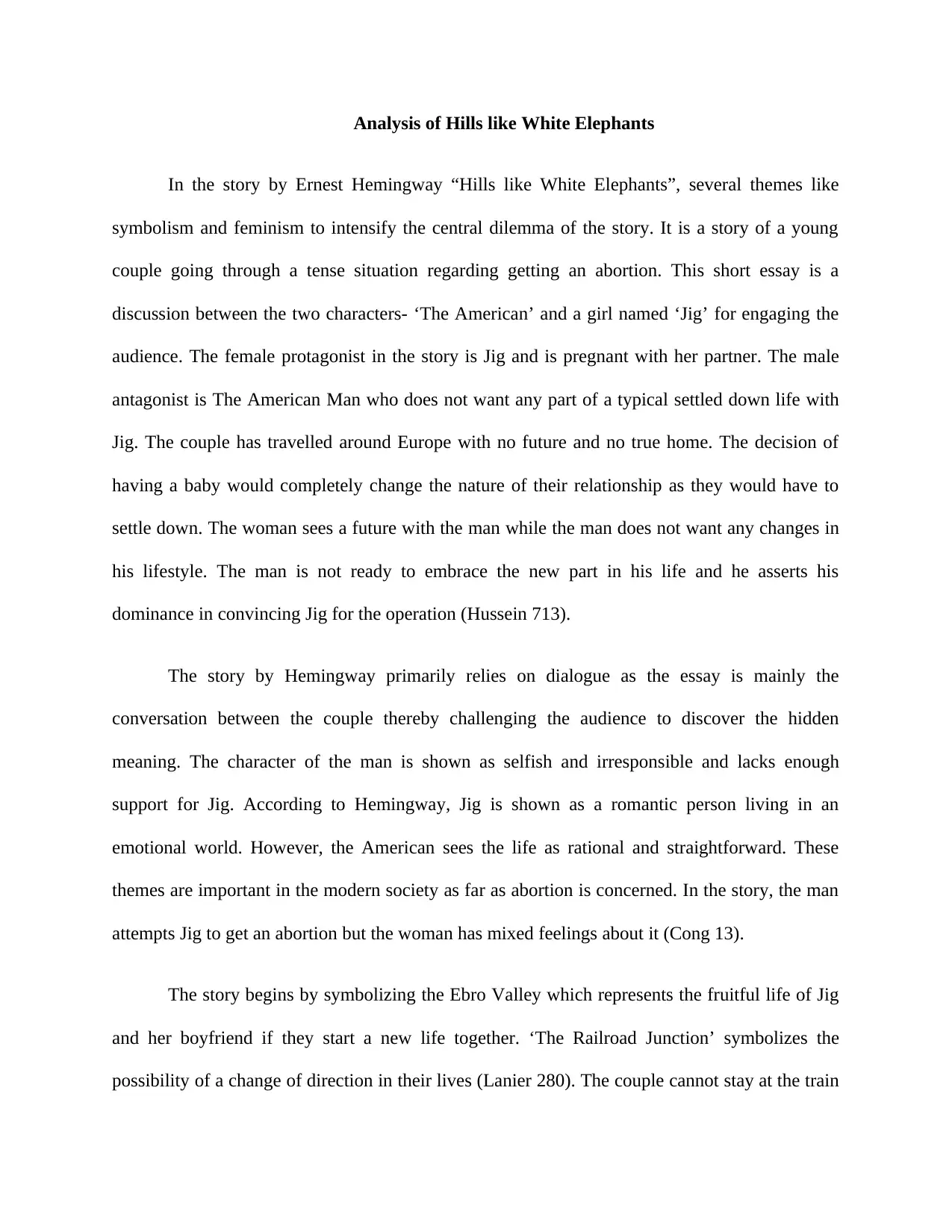
Analysis of Hills like White Elephants
In the story by Ernest Hemingway “Hills like White Elephants”, several themes like
symbolism and feminism to intensify the central dilemma of the story. It is a story of a young
couple going through a tense situation regarding getting an abortion. This short essay is a
discussion between the two characters- ‘The American’ and a girl named ‘Jig’ for engaging the
audience. The female protagonist in the story is Jig and is pregnant with her partner. The male
antagonist is The American Man who does not want any part of a typical settled down life with
Jig. The couple has travelled around Europe with no future and no true home. The decision of
having a baby would completely change the nature of their relationship as they would have to
settle down. The woman sees a future with the man while the man does not want any changes in
his lifestyle. The man is not ready to embrace the new part in his life and he asserts his
dominance in convincing Jig for the operation (Hussein 713).
The story by Hemingway primarily relies on dialogue as the essay is mainly the
conversation between the couple thereby challenging the audience to discover the hidden
meaning. The character of the man is shown as selfish and irresponsible and lacks enough
support for Jig. According to Hemingway, Jig is shown as a romantic person living in an
emotional world. However, the American sees the life as rational and straightforward. These
themes are important in the modern society as far as abortion is concerned. In the story, the man
attempts Jig to get an abortion but the woman has mixed feelings about it (Cong 13).
The story begins by symbolizing the Ebro Valley which represents the fruitful life of Jig
and her boyfriend if they start a new life together. ‘The Railroad Junction’ symbolizes the
possibility of a change of direction in their lives (Lanier 280). The couple cannot stay at the train
In the story by Ernest Hemingway “Hills like White Elephants”, several themes like
symbolism and feminism to intensify the central dilemma of the story. It is a story of a young
couple going through a tense situation regarding getting an abortion. This short essay is a
discussion between the two characters- ‘The American’ and a girl named ‘Jig’ for engaging the
audience. The female protagonist in the story is Jig and is pregnant with her partner. The male
antagonist is The American Man who does not want any part of a typical settled down life with
Jig. The couple has travelled around Europe with no future and no true home. The decision of
having a baby would completely change the nature of their relationship as they would have to
settle down. The woman sees a future with the man while the man does not want any changes in
his lifestyle. The man is not ready to embrace the new part in his life and he asserts his
dominance in convincing Jig for the operation (Hussein 713).
The story by Hemingway primarily relies on dialogue as the essay is mainly the
conversation between the couple thereby challenging the audience to discover the hidden
meaning. The character of the man is shown as selfish and irresponsible and lacks enough
support for Jig. According to Hemingway, Jig is shown as a romantic person living in an
emotional world. However, the American sees the life as rational and straightforward. These
themes are important in the modern society as far as abortion is concerned. In the story, the man
attempts Jig to get an abortion but the woman has mixed feelings about it (Cong 13).
The story begins by symbolizing the Ebro Valley which represents the fruitful life of Jig
and her boyfriend if they start a new life together. ‘The Railroad Junction’ symbolizes the
possibility of a change of direction in their lives (Lanier 280). The couple cannot stay at the train
Paraphrase This Document
Need a fresh take? Get an instant paraphrase of this document with our AI Paraphraser
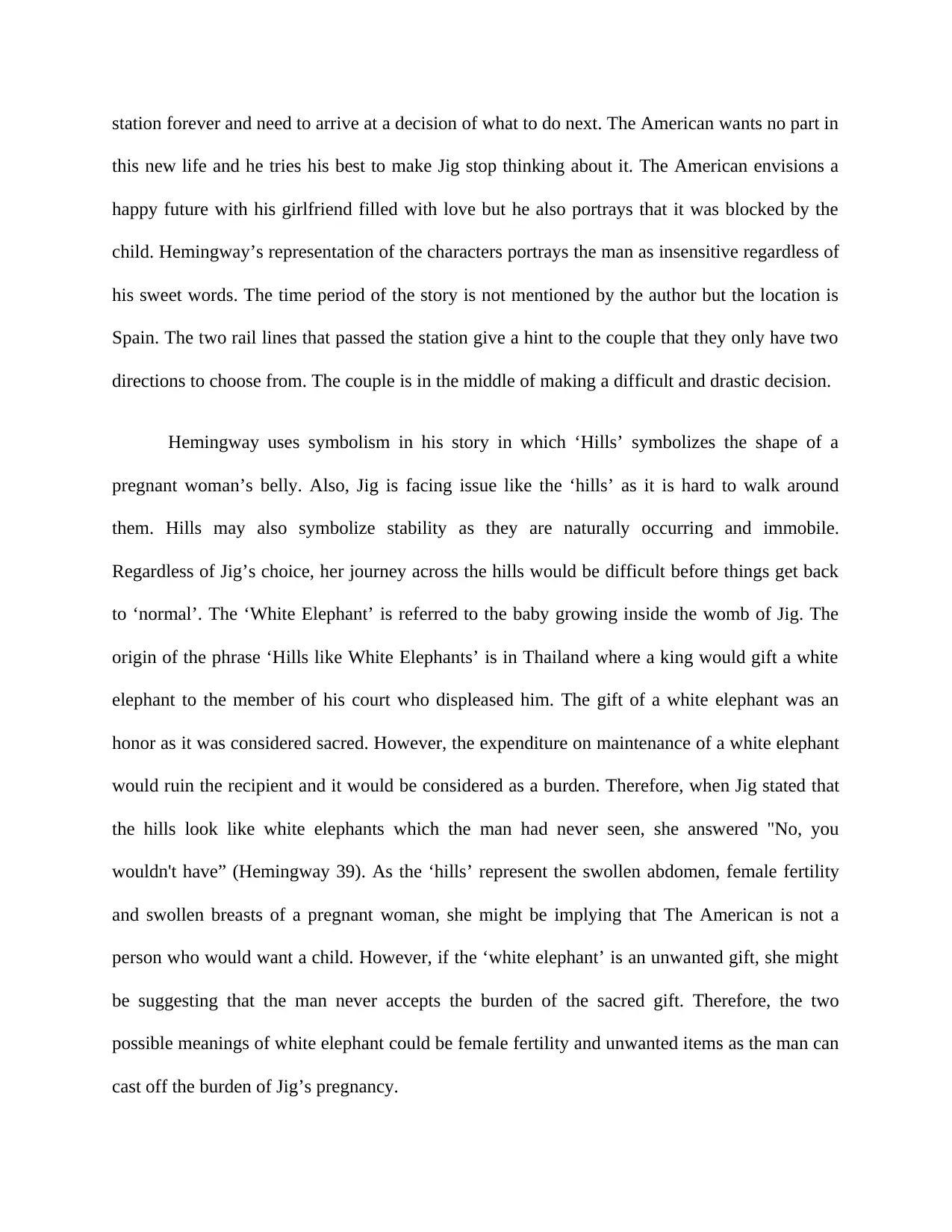
station forever and need to arrive at a decision of what to do next. The American wants no part in
this new life and he tries his best to make Jig stop thinking about it. The American envisions a
happy future with his girlfriend filled with love but he also portrays that it was blocked by the
child. Hemingway’s representation of the characters portrays the man as insensitive regardless of
his sweet words. The time period of the story is not mentioned by the author but the location is
Spain. The two rail lines that passed the station give a hint to the couple that they only have two
directions to choose from. The couple is in the middle of making a difficult and drastic decision.
Hemingway uses symbolism in his story in which ‘Hills’ symbolizes the shape of a
pregnant woman’s belly. Also, Jig is facing issue like the ‘hills’ as it is hard to walk around
them. Hills may also symbolize stability as they are naturally occurring and immobile.
Regardless of Jig’s choice, her journey across the hills would be difficult before things get back
to ‘normal’. The ‘White Elephant’ is referred to the baby growing inside the womb of Jig. The
origin of the phrase ‘Hills like White Elephants’ is in Thailand where a king would gift a white
elephant to the member of his court who displeased him. The gift of a white elephant was an
honor as it was considered sacred. However, the expenditure on maintenance of a white elephant
would ruin the recipient and it would be considered as a burden. Therefore, when Jig stated that
the hills look like white elephants which the man had never seen, she answered "No, you
wouldn't have” (Hemingway 39). As the ‘hills’ represent the swollen abdomen, female fertility
and swollen breasts of a pregnant woman, she might be implying that The American is not a
person who would want a child. However, if the ‘white elephant’ is an unwanted gift, she might
be suggesting that the man never accepts the burden of the sacred gift. Therefore, the two
possible meanings of white elephant could be female fertility and unwanted items as the man can
cast off the burden of Jig’s pregnancy.
this new life and he tries his best to make Jig stop thinking about it. The American envisions a
happy future with his girlfriend filled with love but he also portrays that it was blocked by the
child. Hemingway’s representation of the characters portrays the man as insensitive regardless of
his sweet words. The time period of the story is not mentioned by the author but the location is
Spain. The two rail lines that passed the station give a hint to the couple that they only have two
directions to choose from. The couple is in the middle of making a difficult and drastic decision.
Hemingway uses symbolism in his story in which ‘Hills’ symbolizes the shape of a
pregnant woman’s belly. Also, Jig is facing issue like the ‘hills’ as it is hard to walk around
them. Hills may also symbolize stability as they are naturally occurring and immobile.
Regardless of Jig’s choice, her journey across the hills would be difficult before things get back
to ‘normal’. The ‘White Elephant’ is referred to the baby growing inside the womb of Jig. The
origin of the phrase ‘Hills like White Elephants’ is in Thailand where a king would gift a white
elephant to the member of his court who displeased him. The gift of a white elephant was an
honor as it was considered sacred. However, the expenditure on maintenance of a white elephant
would ruin the recipient and it would be considered as a burden. Therefore, when Jig stated that
the hills look like white elephants which the man had never seen, she answered "No, you
wouldn't have” (Hemingway 39). As the ‘hills’ represent the swollen abdomen, female fertility
and swollen breasts of a pregnant woman, she might be implying that The American is not a
person who would want a child. However, if the ‘white elephant’ is an unwanted gift, she might
be suggesting that the man never accepts the burden of the sacred gift. Therefore, the two
possible meanings of white elephant could be female fertility and unwanted items as the man can
cast off the burden of Jig’s pregnancy.
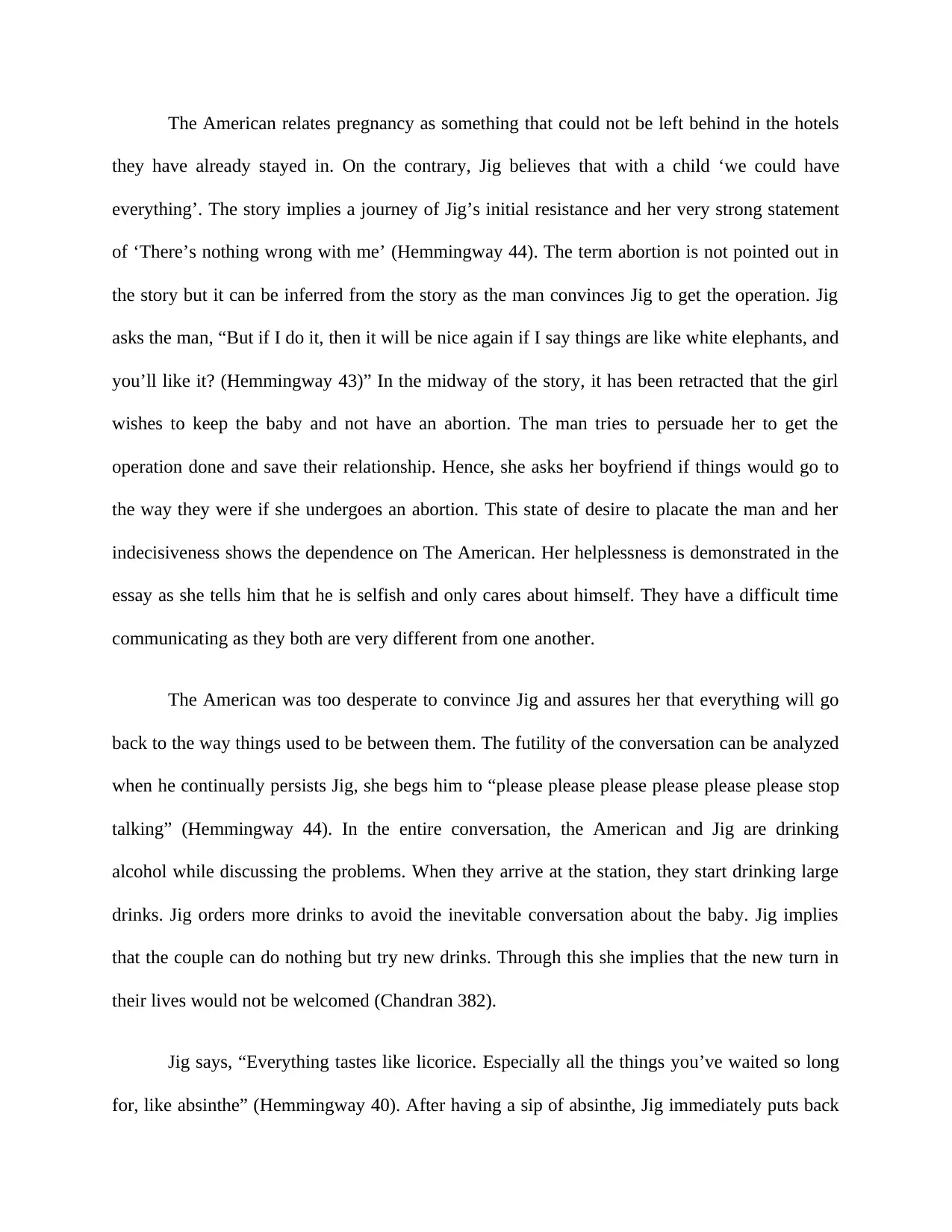
The American relates pregnancy as something that could not be left behind in the hotels
they have already stayed in. On the contrary, Jig believes that with a child ‘we could have
everything’. The story implies a journey of Jig’s initial resistance and her very strong statement
of ‘There’s nothing wrong with me’ (Hemmingway 44). The term abortion is not pointed out in
the story but it can be inferred from the story as the man convinces Jig to get the operation. Jig
asks the man, “But if I do it, then it will be nice again if I say things are like white elephants, and
you’ll like it? (Hemmingway 43)” In the midway of the story, it has been retracted that the girl
wishes to keep the baby and not have an abortion. The man tries to persuade her to get the
operation done and save their relationship. Hence, she asks her boyfriend if things would go to
the way they were if she undergoes an abortion. This state of desire to placate the man and her
indecisiveness shows the dependence on The American. Her helplessness is demonstrated in the
essay as she tells him that he is selfish and only cares about himself. They have a difficult time
communicating as they both are very different from one another.
The American was too desperate to convince Jig and assures her that everything will go
back to the way things used to be between them. The futility of the conversation can be analyzed
when he continually persists Jig, she begs him to “please please please please please please stop
talking” (Hemmingway 44). In the entire conversation, the American and Jig are drinking
alcohol while discussing the problems. When they arrive at the station, they start drinking large
drinks. Jig orders more drinks to avoid the inevitable conversation about the baby. Jig implies
that the couple can do nothing but try new drinks. Through this she implies that the new turn in
their lives would not be welcomed (Chandran 382).
Jig says, “Everything tastes like licorice. Especially all the things you’ve waited so long
for, like absinthe” (Hemmingway 40). After having a sip of absinthe, Jig immediately puts back
they have already stayed in. On the contrary, Jig believes that with a child ‘we could have
everything’. The story implies a journey of Jig’s initial resistance and her very strong statement
of ‘There’s nothing wrong with me’ (Hemmingway 44). The term abortion is not pointed out in
the story but it can be inferred from the story as the man convinces Jig to get the operation. Jig
asks the man, “But if I do it, then it will be nice again if I say things are like white elephants, and
you’ll like it? (Hemmingway 43)” In the midway of the story, it has been retracted that the girl
wishes to keep the baby and not have an abortion. The man tries to persuade her to get the
operation done and save their relationship. Hence, she asks her boyfriend if things would go to
the way they were if she undergoes an abortion. This state of desire to placate the man and her
indecisiveness shows the dependence on The American. Her helplessness is demonstrated in the
essay as she tells him that he is selfish and only cares about himself. They have a difficult time
communicating as they both are very different from one another.
The American was too desperate to convince Jig and assures her that everything will go
back to the way things used to be between them. The futility of the conversation can be analyzed
when he continually persists Jig, she begs him to “please please please please please please stop
talking” (Hemmingway 44). In the entire conversation, the American and Jig are drinking
alcohol while discussing the problems. When they arrive at the station, they start drinking large
drinks. Jig orders more drinks to avoid the inevitable conversation about the baby. Jig implies
that the couple can do nothing but try new drinks. Through this she implies that the new turn in
their lives would not be welcomed (Chandran 382).
Jig says, “Everything tastes like licorice. Especially all the things you’ve waited so long
for, like absinthe” (Hemmingway 40). After having a sip of absinthe, Jig immediately puts back
⊘ This is a preview!⊘
Do you want full access?
Subscribe today to unlock all pages.

Trusted by 1+ million students worldwide
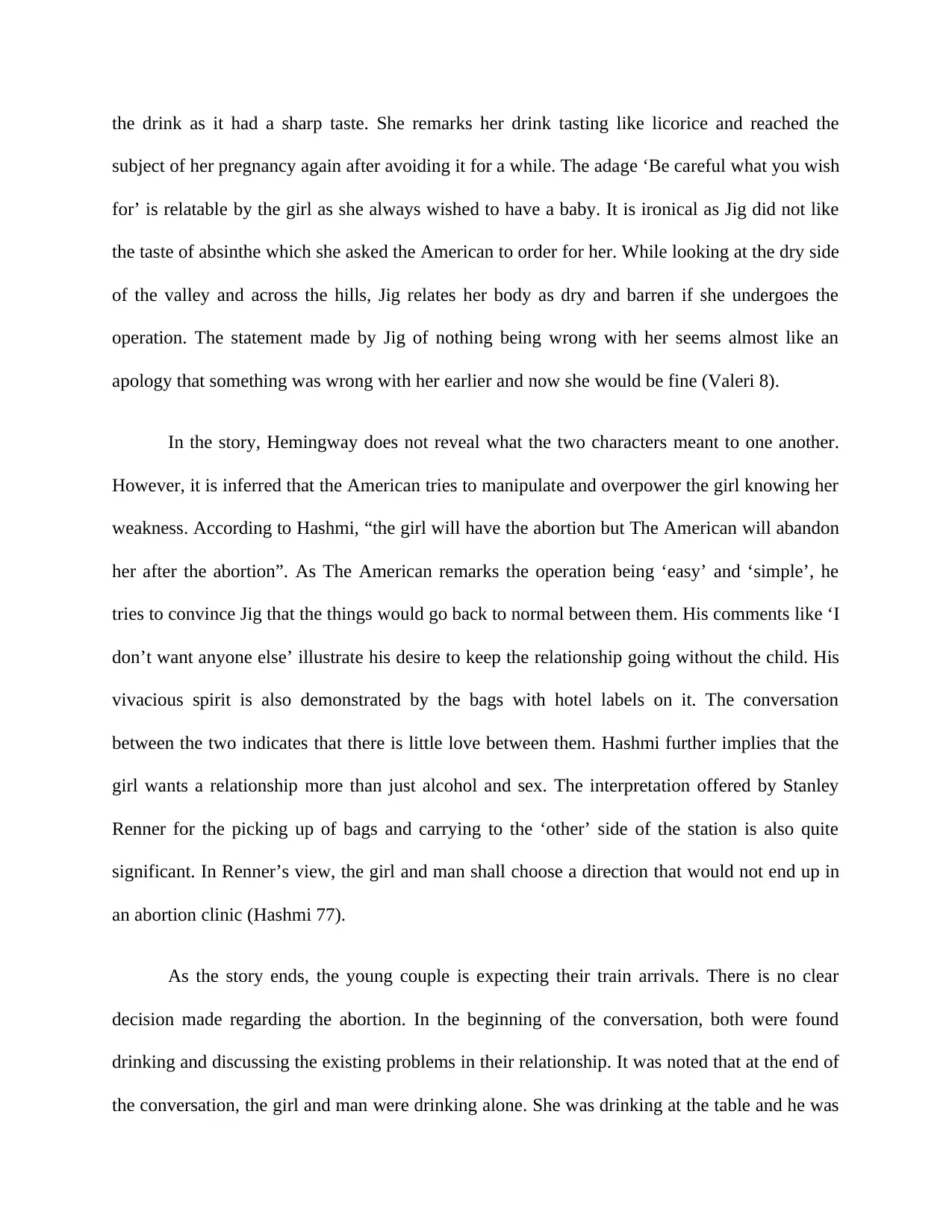
the drink as it had a sharp taste. She remarks her drink tasting like licorice and reached the
subject of her pregnancy again after avoiding it for a while. The adage ‘Be careful what you wish
for’ is relatable by the girl as she always wished to have a baby. It is ironical as Jig did not like
the taste of absinthe which she asked the American to order for her. While looking at the dry side
of the valley and across the hills, Jig relates her body as dry and barren if she undergoes the
operation. The statement made by Jig of nothing being wrong with her seems almost like an
apology that something was wrong with her earlier and now she would be fine (Valeri 8).
In the story, Hemingway does not reveal what the two characters meant to one another.
However, it is inferred that the American tries to manipulate and overpower the girl knowing her
weakness. According to Hashmi, “the girl will have the abortion but The American will abandon
her after the abortion”. As The American remarks the operation being ‘easy’ and ‘simple’, he
tries to convince Jig that the things would go back to normal between them. His comments like ‘I
don’t want anyone else’ illustrate his desire to keep the relationship going without the child. His
vivacious spirit is also demonstrated by the bags with hotel labels on it. The conversation
between the two indicates that there is little love between them. Hashmi further implies that the
girl wants a relationship more than just alcohol and sex. The interpretation offered by Stanley
Renner for the picking up of bags and carrying to the ‘other’ side of the station is also quite
significant. In Renner’s view, the girl and man shall choose a direction that would not end up in
an abortion clinic (Hashmi 77).
As the story ends, the young couple is expecting their train arrivals. There is no clear
decision made regarding the abortion. In the beginning of the conversation, both were found
drinking and discussing the existing problems in their relationship. It was noted that at the end of
the conversation, the girl and man were drinking alone. She was drinking at the table and he was
subject of her pregnancy again after avoiding it for a while. The adage ‘Be careful what you wish
for’ is relatable by the girl as she always wished to have a baby. It is ironical as Jig did not like
the taste of absinthe which she asked the American to order for her. While looking at the dry side
of the valley and across the hills, Jig relates her body as dry and barren if she undergoes the
operation. The statement made by Jig of nothing being wrong with her seems almost like an
apology that something was wrong with her earlier and now she would be fine (Valeri 8).
In the story, Hemingway does not reveal what the two characters meant to one another.
However, it is inferred that the American tries to manipulate and overpower the girl knowing her
weakness. According to Hashmi, “the girl will have the abortion but The American will abandon
her after the abortion”. As The American remarks the operation being ‘easy’ and ‘simple’, he
tries to convince Jig that the things would go back to normal between them. His comments like ‘I
don’t want anyone else’ illustrate his desire to keep the relationship going without the child. His
vivacious spirit is also demonstrated by the bags with hotel labels on it. The conversation
between the two indicates that there is little love between them. Hashmi further implies that the
girl wants a relationship more than just alcohol and sex. The interpretation offered by Stanley
Renner for the picking up of bags and carrying to the ‘other’ side of the station is also quite
significant. In Renner’s view, the girl and man shall choose a direction that would not end up in
an abortion clinic (Hashmi 77).
As the story ends, the young couple is expecting their train arrivals. There is no clear
decision made regarding the abortion. In the beginning of the conversation, both were found
drinking and discussing the existing problems in their relationship. It was noted that at the end of
the conversation, the girl and man were drinking alone. She was drinking at the table and he was
Paraphrase This Document
Need a fresh take? Get an instant paraphrase of this document with our AI Paraphraser
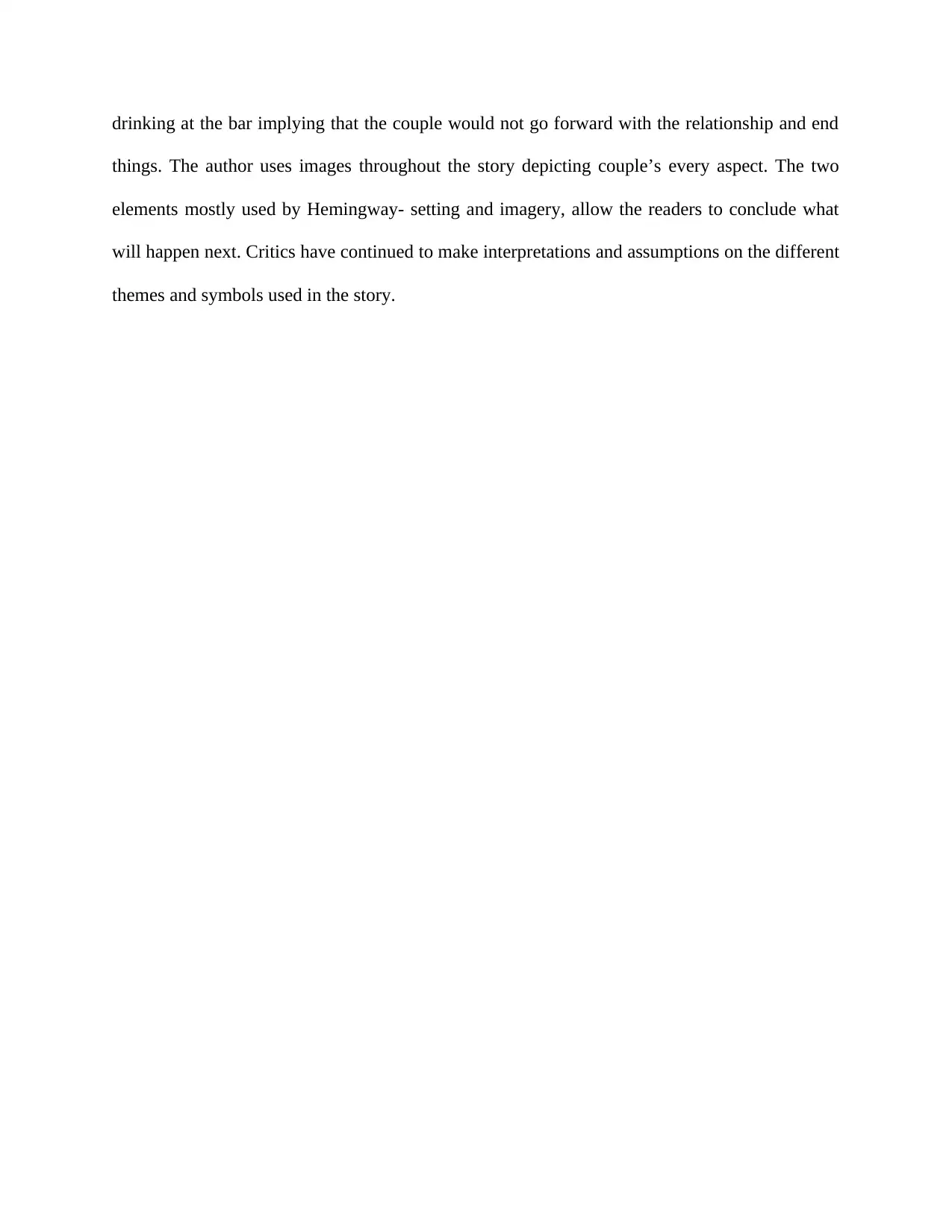
drinking at the bar implying that the couple would not go forward with the relationship and end
things. The author uses images throughout the story depicting couple’s every aspect. The two
elements mostly used by Hemingway- setting and imagery, allow the readers to conclude what
will happen next. Critics have continued to make interpretations and assumptions on the different
themes and symbols used in the story.
things. The author uses images throughout the story depicting couple’s every aspect. The two
elements mostly used by Hemingway- setting and imagery, allow the readers to conclude what
will happen next. Critics have continued to make interpretations and assumptions on the different
themes and symbols used in the story.
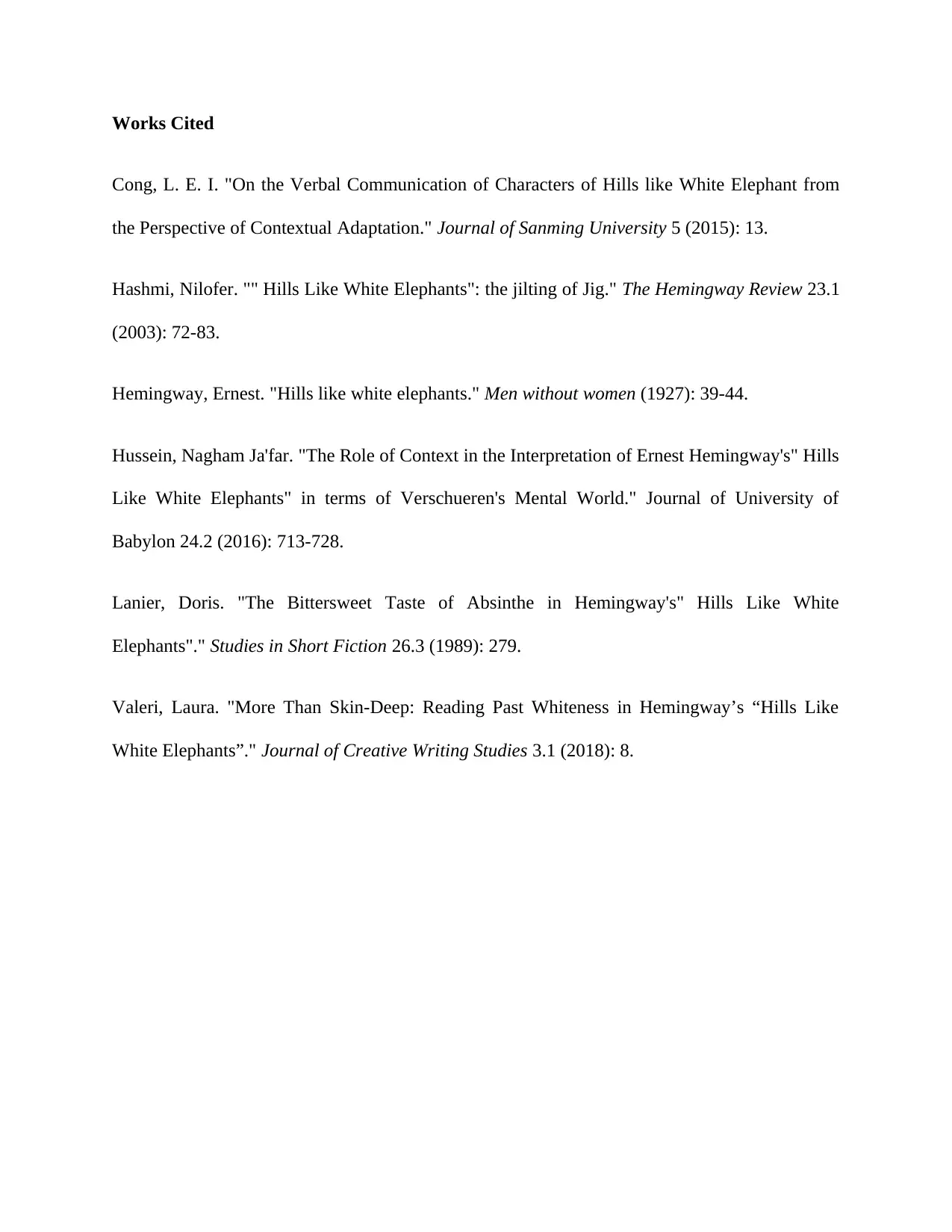
Works Cited
Cong, L. E. I. "On the Verbal Communication of Characters of Hills like White Elephant from
the Perspective of Contextual Adaptation." Journal of Sanming University 5 (2015): 13.
Hashmi, Nilofer. "" Hills Like White Elephants": the jilting of Jig." The Hemingway Review 23.1
(2003): 72-83.
Hemingway, Ernest. "Hills like white elephants." Men without women (1927): 39-44.
Hussein, Nagham Ja'far. "The Role of Context in the Interpretation of Ernest Hemingway's" Hills
Like White Elephants" in terms of Verschueren's Mental World." Journal of University of
Babylon 24.2 (2016): 713-728.
Lanier, Doris. "The Bittersweet Taste of Absinthe in Hemingway's" Hills Like White
Elephants"." Studies in Short Fiction 26.3 (1989): 279.
Valeri, Laura. "More Than Skin-Deep: Reading Past Whiteness in Hemingway’s “Hills Like
White Elephants”." Journal of Creative Writing Studies 3.1 (2018): 8.
Cong, L. E. I. "On the Verbal Communication of Characters of Hills like White Elephant from
the Perspective of Contextual Adaptation." Journal of Sanming University 5 (2015): 13.
Hashmi, Nilofer. "" Hills Like White Elephants": the jilting of Jig." The Hemingway Review 23.1
(2003): 72-83.
Hemingway, Ernest. "Hills like white elephants." Men without women (1927): 39-44.
Hussein, Nagham Ja'far. "The Role of Context in the Interpretation of Ernest Hemingway's" Hills
Like White Elephants" in terms of Verschueren's Mental World." Journal of University of
Babylon 24.2 (2016): 713-728.
Lanier, Doris. "The Bittersweet Taste of Absinthe in Hemingway's" Hills Like White
Elephants"." Studies in Short Fiction 26.3 (1989): 279.
Valeri, Laura. "More Than Skin-Deep: Reading Past Whiteness in Hemingway’s “Hills Like
White Elephants”." Journal of Creative Writing Studies 3.1 (2018): 8.
⊘ This is a preview!⊘
Do you want full access?
Subscribe today to unlock all pages.

Trusted by 1+ million students worldwide
1 out of 6
Related Documents
Your All-in-One AI-Powered Toolkit for Academic Success.
+13062052269
info@desklib.com
Available 24*7 on WhatsApp / Email
![[object Object]](/_next/static/media/star-bottom.7253800d.svg)
Unlock your academic potential
Copyright © 2020–2025 A2Z Services. All Rights Reserved. Developed and managed by ZUCOL.




